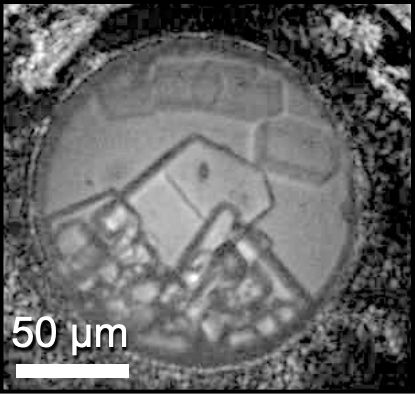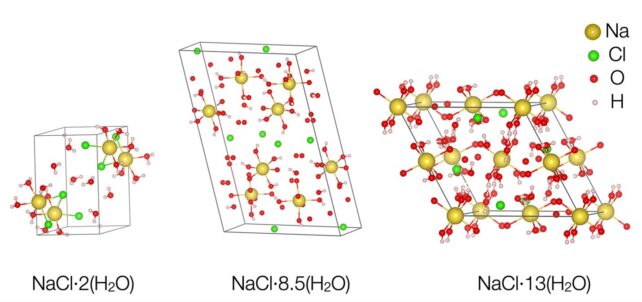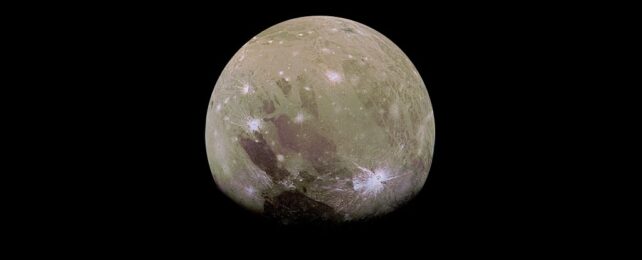Two newly discovered forms of frozen salt water could help scientists resolve a mystery concerning the Solar System's ice-encrusted moons.
When subjected to higher pressures and lower temperatures than can be found in nature on Earth, the atoms in hydrated sodium chloride – more commonly known as salt water ice – arranged themselves in never-before-identified structures that have a much higher proportion of water molecules than salt.
This could explain the strange chemical signature of a substance on the surface of Jupiter's moon Europa, which seems more watery than scientists expect.
"It's rare nowadays to have fundamental discoveries in science," says Earth and space scientist Baptiste Journaux of the University of Washington.
"Salt and water are very well known at Earth conditions. But beyond that, we're totally in the dark. And now we have these planetary objects that probably have compounds that are very familiar to us, but in very exotic conditions. We have to redo all the fundamental mineralogical science that people did in the 1800s, but at high pressure and low temperature. It is an exciting time."
Salt and water are both abundant on our home world. When combined, molecules of salt dissolve throughout those of water to create a solution. The presence of the salt lowers the freezing point of the solution compared to unsalted water, but as the temperature continues to drop under typical Earth atmospheric conditions, it will eventually freeze.

When it does so, the molecules arrange themselves in a rigid lattice structure known as a hydrate. On Earth (outside of the laboratory), this structure only has one configuration: one salt molecule for every two water molecules.
On moons like Europa and Ganymede, which orbit Jupiter, and Saturn's moon Enceladus, scientists have also found evidence of salt and water, only the conditions both are found in happen to be rather different to those on Earth.
Exposed to the near vacuum of space, far from the Sun, the surfaces of these distant worlds can get extremely cold. Beneath their coats of ice lay oceans that could in some cases be more than 100 times thicker than the deepest waters on Earth, making for some pretty extreme pressures and temperatures.
Journaux and his colleagues set out to investigate the impact salt has on the production of ice. They compressed a tiny blob of salt water in a diamond anvil cell under extremely cold conditions, generating pressures up to 25,000 times Earth's atmospheric pressure while lowering temperatures to -123 degrees Celsius (-190 degrees Fahrenheit).
They were not expecting what happened next.
"We were trying to measure how adding salt would change the amount of ice we could get, since salt acts as an antifreeze," Journaux explains. "Surprisingly, when we put the pressure on, what we saw is that these crystals that we were not expecting started growing. It was a very serendipitous discovery."

Under their experiment's conditions, the researchers saw two new arrangements of salt and water molecule emerge. One featured two salt molecules for every 17 water molecules; the other had 13 water molecules for one salt molecule. Both are very different from the one salt, two water seen naturally on Earth – and consistent with the watery chemical signatures observed on the ice moons.
"It has the structure that planetary scientists have been waiting for," adds Journaux.
The main factor, the researchers say, is pressure, which squishes the molecules together and forces them to find new ways to coexist. But even when the pressure was released, one of the newly identified hydrates – the one with 17 water molecules – remained stable up to temperatures of -50 degrees Celsius. This suggests that it could be found here on Earth, too, possibly under Antarctica's ice.
Future research will need to be undertaken to determine whether this discovery can resolve the icy moon mystery.
"[The hydrate's] infrared spectra remain to be determined in future studies," the researchers write, "but its hyperhydrated structure could solve the long-standing mystery of the unidentified hydrate phase at the surface of Europa and Ganymede."
The research has been published in Proceedings of the National Academy of Sciences.
